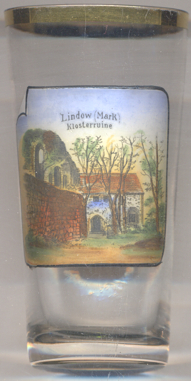

|
| DEUTSCHLAND | GERMANY |
| Bundesland: Brandenburg | |
| Landkreis: Ostprignitz-Ruppin |
 Lindow (Mark) is situated at an elevation of 41 m in the nature reserve Stechlin-Ruppiner Land of northern
Brandenburg in the district Ostprignitz-Ruppin, about 14 km northeast of the district town
Neuruppin and about 60 km north of Berlin. The municipality of
Lindow (Mark) has a population of about 3,050 (2017).
Lindow (Mark) is situated at an elevation of 41 m in the nature reserve Stechlin-Ruppiner Land of northern
Brandenburg in the district Ostprignitz-Ruppin, about 14 km northeast of the district town
Neuruppin and about 60 km north of Berlin. The municipality of
Lindow (Mark) has a population of about 3,050 (2017).
In the course of the medieval eastward migrations of Germans, the count of Arnstein conquered the area around today's Lindow. In 1196 he settled in the castle of Ruppin, located in today's Alt Ruppin, a locality of Neuruppin. The comital family later adopted the name counts of Lindow-Ruppin. By 1220 or 1240 the counts founded a Cistercian nunnery in Lindow and richly enfeoffed it with lands and villages. Next to the nunnery a settlement developed which was first named in a document of 1343. With the extinction of the comital family in the male line the comital fief was reverted to the prince-electors of Brandenburg in 1524. After the prince-elector adopted Lutheranism in 1539 the nunnery was secularised in 1541/1542. The former nunnnery then continued to serve as a Lutheran women's convent. The town suffered heavily during the Thirty Years' War (1618–1648). In 1746 a large fire burnt most of Lindow to ashes. Lindow lived through the changes after the First World War and the takeover by the Nazis in 1933. Between September 1937 and the end of 1944 the SS organisation Lebensborn ran the home Kurmark in Klosterheide, a component village of Lindow north of the town. After World War II Lindow became part of the Soviet Occupation Zone in Germany. The damsels' foundation became a Protestant home for elderly of all backgrounds, many terribly impoverished by the impacts of the war. Since 1998, Lindow (Mark) has the status of a state-recognised resort town. The neighbouring communities of Banzendorf, Keller and Klosterheide were incorporated into Lindow in 2001/2002, Hindenberg and Schönberg (Mark) followed in 2003.
 Lindow monastery [left] was founded around 1230 by the counts of
Arnstein as a Cistercian nunnery. After the death in 1524 of the last male member of the family, the nunnery came into
possession of the prince-electors of Brandenburg. At that time it was one of the richest monasteries of the margraviate
Brandenburg. After 1541, it was converted into a Lutheran ladies' convent; the last of its members died in the 1960s.
Most of the monastery buildings were destroyed during the Thirty Years' War and some of the ruins still exist today.
Lindow Monastery was the model for the monastery 'Wutz' in Theodor Fontane's novel Der Stechlin.
Lindow monastery [left] was founded around 1230 by the counts of
Arnstein as a Cistercian nunnery. After the death in 1524 of the last male member of the family, the nunnery came into
possession of the prince-electors of Brandenburg. At that time it was one of the richest monasteries of the margraviate
Brandenburg. After 1541, it was converted into a Lutheran ladies' convent; the last of its members died in the 1960s.
Most of the monastery buildings were destroyed during the Thirty Years' War and some of the ruins still exist today.
Lindow Monastery was the model for the monastery 'Wutz' in Theodor Fontane's novel Der Stechlin.
[https://de.wikipedia.org/wiki/Lindow_(Mark) [21.02.2019], https://en.wikipedia.org/wiki/Lindow_(Mark) [21.02.2019];
https://de.wikipedia.org/wiki/Kloster_Lindow [21.02.2019]]
![[scale]](lineal.jpg)